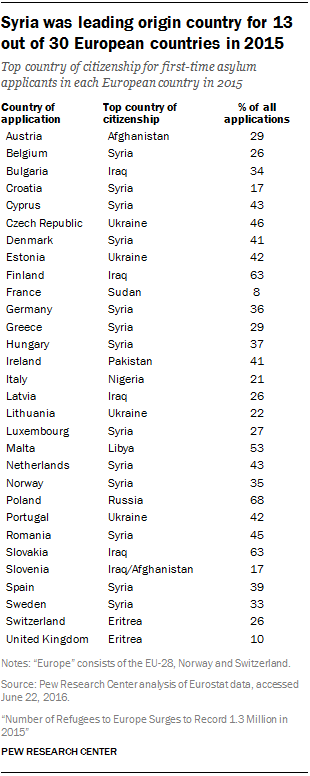
Asylum seekers make their way to Europe in fits and starts, by direct as well as indirect routes, by air, land and sea. Consequently, it is difficult to trace the precise paths taken by thousands of asylum seekers. However, by pairing the country where a migrant is seeking asylum with the country that same migrant lists as country of citizenship, it is possible to identify “bilateral migration corridors” – i.e., flows between points of origin and destination. These corridors can provide a sense for who is seeking asylum where.
In the case of Syrian refugees moving between the Middle East and Europe in 2015, fully 84% applied for asylum in just five countries (Germany, Hungary, Sweden, Austria and the Netherlands). The Syria-Germany corridor was the most active one in 2015, with 159,000 Syrians seeking asylum in Germany. Other major corridors included Syria-Hungary (64,000 asylum seekers), Albania-Germany (54,000) and Syria-Sweden (51,000).

Syria has been the point of origin for the largest asylum seeker corridors during the past few years. This was true in 2015 as well as 2014, when Europe’s largest asylum seeker corridor was also Syria to Germany, with 39,000 applicants or 7% of asylum applications in Europe. In 2013, the Syria-Sweden corridor was the largest asylum seeker flow, numbering 17,000 people or 4% of all asylum applications.
Afghanistan, Iraq, Kosovo, Albania and Nigeria were the leading source countries after Syria in 2015 for asylum seeker flows to specific countries within Europe.
The intensity of 2015’s sudden migration of asylum seekers was felt more acutely in some European countries than in others. By far, Hungary (1,770 per 100,000 in Hungary’s population), Sweden (1,600 per 100,000) and Austria (1,000 per 100,000) felt the effects of the asylum seeker surge the most in 2015. Germany (540 per 100,000) had a higher per capita number of asylum applicants than Europe (250 per 100,000) as a whole and was similar to other leading destinations such as Finland (590 per 100,000), Norway (590 per 100,000) and Switzerland (460 per 100,000). By contrast, France (110 per 100,000) and the UK (60 per 100,000) had a far lower per capita number of asylum seekers.
Syrian refugees did not evenly disperse in Europe
As suggested above, Syrian and other asylum seekers have tended to concentrate along specific migration corridors en route to Europe. This has contributed to the uneven distribution of asylum seekers across the EU-28, Norway and Switzerland. In some countries, particular groups make up a sizable portion of all asylum seekers, even when the countries in question are not part of Europe’s main asylee corridors.
In 2015, Syria was the leading source country of asylum seekers in 13 out of 30 European countries. Among these nearly dozen countries, Syrian asylees constituted a third or more of all asylum seekers in Romania (45%), Cyprus (43%), Netherlands (43%), Denmark (41%), Spain (39%), Hungary (37%), Germany (36%), Norway (35%) and Sweden (33%). In no country did Syrians make up more than half of all asylum seekers.
Asylees from Ukraine were the largest group of asylum seekers in four countries last year: Portugal (42%), Estonia (42%), Czech Republic (46%) and Lithuania (22%), while Iraqis were the largest contingent of asylum applicants in Slovakia (63%), Finland (63%) and Bulgaria (34%). No other group, including Afghans, was the predominant source of asylum seekers in more than two European countries in 2015.




